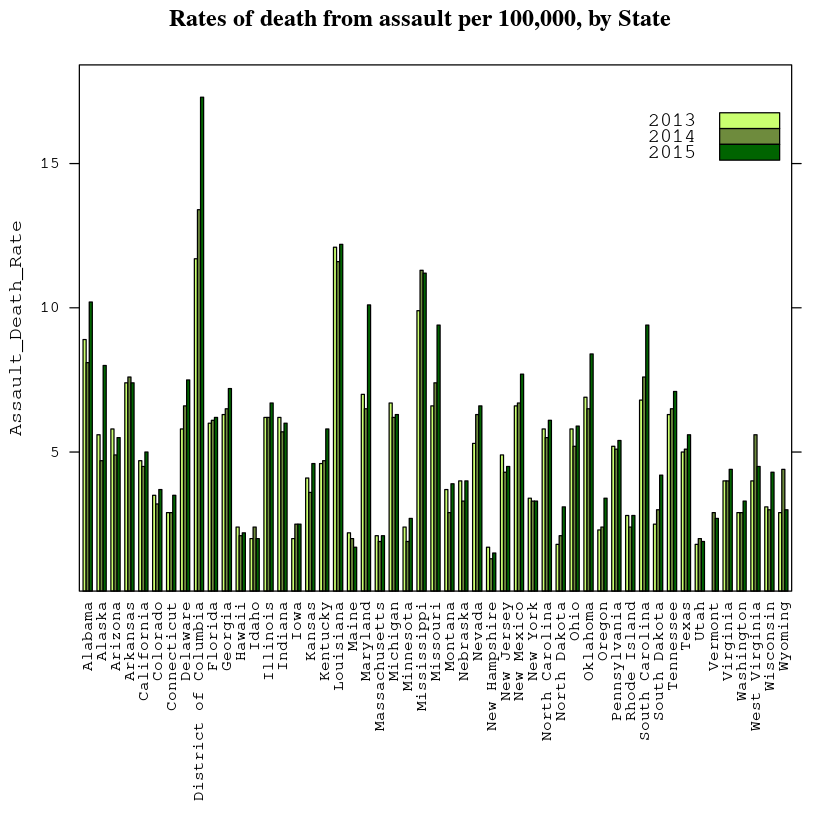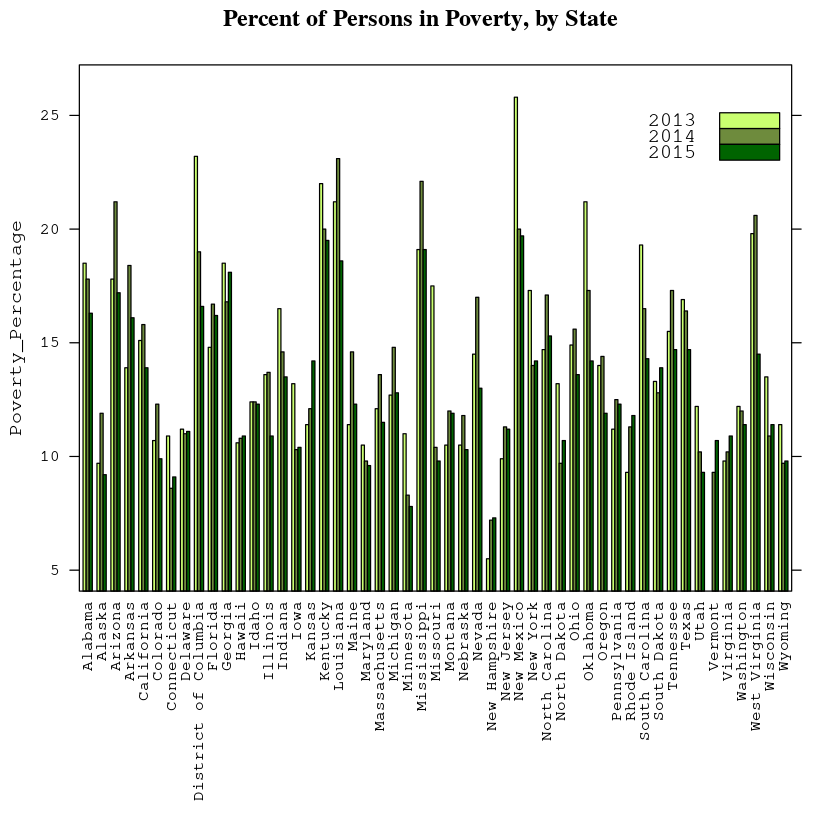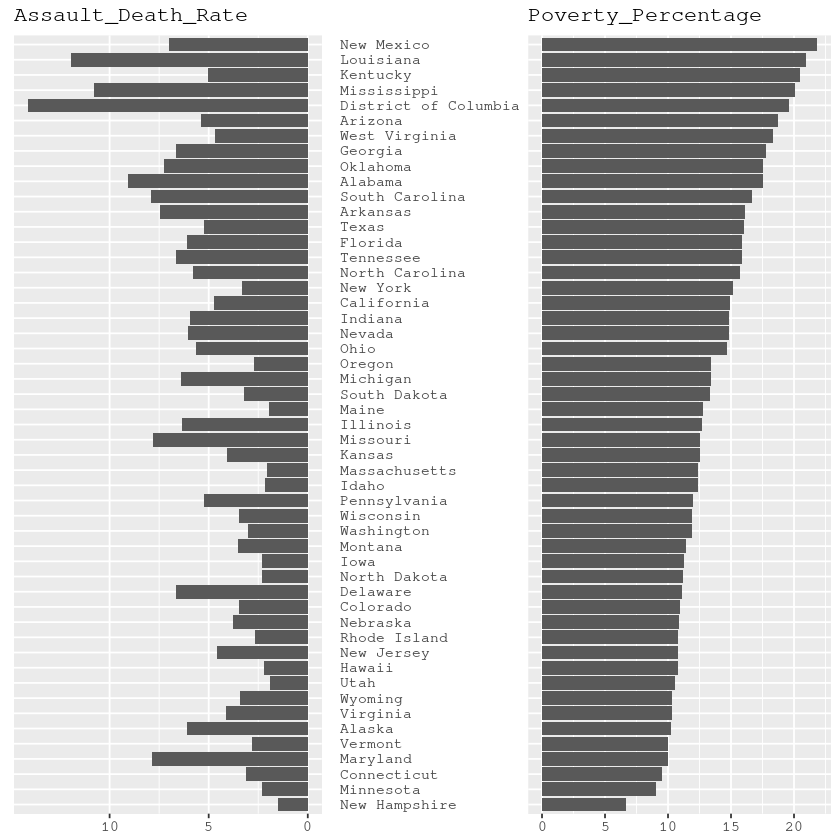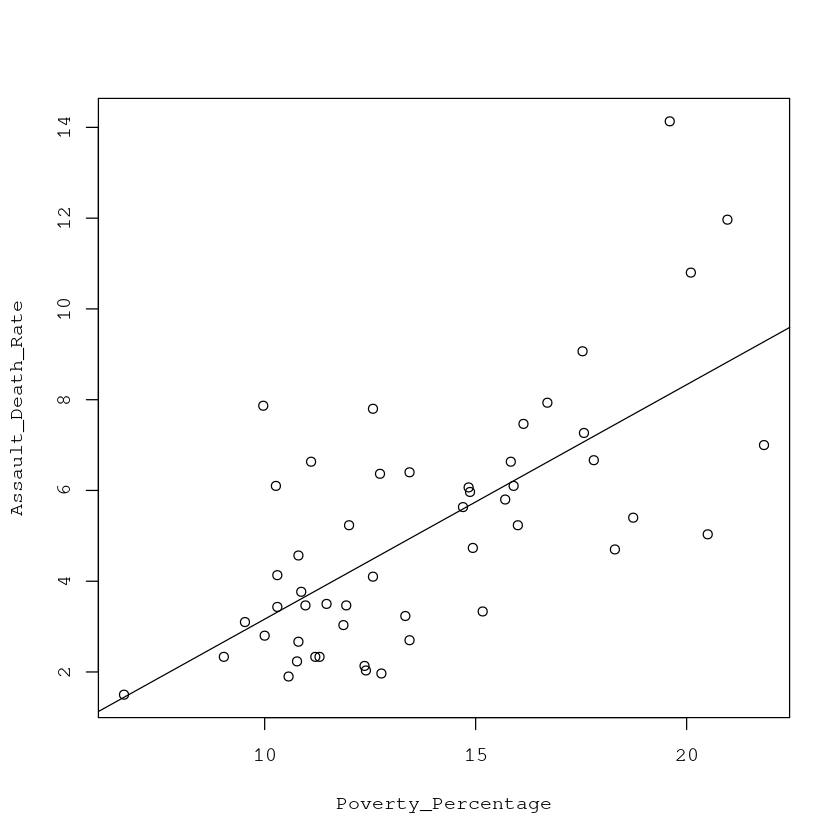Exploring the Rates of Assault Death and Poverty
Tags: Jupyter Notebook RThe original Jupyter Notebook can be viewed here.
This post will explore the rates of assault death and poverty in the US.
Source of original data:
- Assault: https://wonder.cdc.gov, Compressed Mortality, 2013-2015, ICD-10 codes: X85-Y09 (Assault)
- Poverty: https://www.census.gov/data/tables/time-series/demo/income-poverty/historical-poverty-people.html, Table 19. Percent of Persons in Poverty, by State, 2013-2015
I generated a csv file combined.csv using SQLite (see here for the SQL queries), which contains 4 columns:
- State: State names
- Year: Year of the data, 2013-2015
- Assault_Death_Rate: Rates of death from assault per 100,000 (using 2000 U.S. Std. Population), age adjusted
- Poverty_Percentage: Percentage of persons in poverty
Here I will use this combined.csv file for analysis.
# Load libraries
library(lattice)
library(ggplot2)
library(gridExtra)
# Read combined.csv (generated from SQL) into R
combined <- read.csv(file = 'combined.csv', header = TRUE, sep=',')
# Brief look at the data
summary(combined)
State Year Assault_Death_Rate Poverty_Percentage
Alabama : 3 Min. :2013 Min. : 1.300 Min. : 5.50
Alaska : 3 1st Qu.:2013 1st Qu.: 2.900 1st Qu.:10.90
Arizona : 3 Median :2014 Median : 4.700 Median :13.10
Arkansas : 3 Mean :2014 Mean : 5.114 Mean :13.77
California: 3 3rd Qu.:2015 3rd Qu.: 6.500 3rd Qu.:16.43
Colorado : 3 Max. :2015 Max. :17.300 Max. :25.80
(Other) :134
# Barchart of Assault_Death_Rate by State
barchart(Assault_Death_Rate ~ State, data = combined, groups = Year, scales = list(x = list(rot = 90)),
auto.key = list(corner = c(1,0.9)), main = 'Rates of death from assault per 100,000, by State',
par.settings=list(superpose.polygon = list(col = c('darkolivegreen1','darkolivegreen4', 'darkgreen'))))

# Barchart of Poverty_Percentage by State
barchart(Poverty_Percentage ~ State, data = combined, groups = Year, scales = list(x = list(rot = 90)),
auto.key = list(corner = c(1,0.9)), main = 'Percent of Persons in Poverty, by State',
par.settings=list(superpose.polygon = list(col = c('darkolivegreen1','darkolivegreen4', 'darkgreen'))))

The graphs show that for most states, neither Assault_Death_Rate or Poverty_Percentage vary dramatically during 2013-2015. Thus I decided the three year data could be summarized sufficiently by the three-year mean.
# Plot the mean
combined_mean <- aggregate(cbind(Assault_Death_Rate, Poverty_Percentage) ~ State, combined, mean)
head(combined_mean,10)
| Alabama | 9.066667 | 17.533333 |
| Alaska | 6.100000 | 10.266667 |
| Arizona | 5.400000 | 18.733333 |
| Arkansas | 7.466667 | 16.133333 |
| California | 4.733333 | 14.933333 |
| Colorado | 3.466667 | 10.966667 |
| Connecticut | 3.100000 | 9.533333 |
| Delaware | 6.633333 | 11.100000 |
| District of Columbia | 14.133333 | 19.600000 |
| Florida | 6.100000 | 15.900000 |
# This is a hacky way to produce a back-to-back horizontal bar plot.
p1 <- ggplot(data = combined_mean, aes(x = reorder(State, Poverty_Percentage) , y = Assault_Death_Rate)) +
geom_bar(stat="identity") + coord_flip() + scale_y_reverse() + ggtitle('Assault_Death_Rate') +
theme(axis.ticks.y = element_blank(), axis.text.y = element_blank(), axis.title.y = element_blank(),
axis.title.x = element_blank())
p2 <- ggplot(data = combined_mean, aes(x = reorder(State, Poverty_Percentage), y = Poverty_Percentage)) +
geom_bar(stat="identity") + ggtitle('Poverty_Percentage') + coord_flip() +
theme(axis.ticks.y = element_blank(), axis.title.y = element_blank(), axis.text.y = element_text(hjust=0),
axis.title.x = element_blank())
grid.arrange(p1, p2, ncol=2, widths = c(1.3, 2))

The bar graph above indicates there is correlation between the assault death rate and the poverty rate. The corrlation can be calculated as:
cor(combined_mean$Assault_Death_Rate, combined_mean$Poverty_Percentage)
0.678625334965831
A scatter plot of Assault_Death_Rate ~ Poverty_Percentage suggests they have an approximately linear relationship.
plot(Assault_Death_Rate ~ Poverty_Percentage, data = combined_mean)
abline(lm(Assault_Death_Rate ~ Poverty_Percentage, data = combined_mean))

Of course, in real life there are a lot more nuances we need to consider to fully explore the relationship between the assault death rate and the poverty rate. For example, we may need to ask whether aggregation at the state level is appropriate. And of course correlation does not imply causation. Nevertheless, this exploration of public data set demonstrated the use of SQLite and R as useful open source data analysis tools.